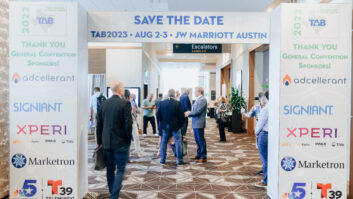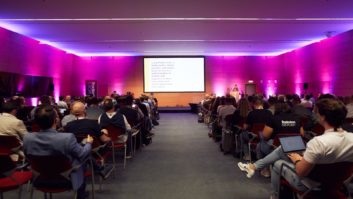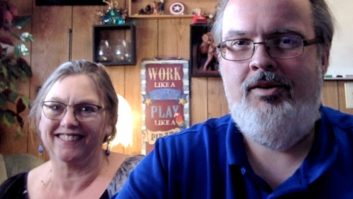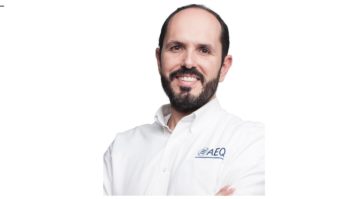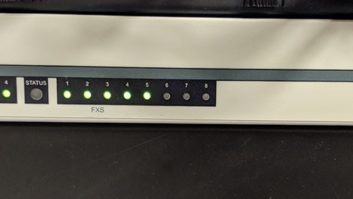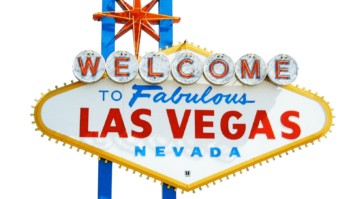Broadcast Engineering Conference
- Sunday morning April 13: “Digital Opportunities for Radio”
- Sunday afternoon April 13: “Radio Technology Advancements”
The Broadcast Engineering Conference gets underway in earnest Sunday April 13, and the day’s agenda is crowded with sessions concerning the opportunities provided by digital radio and other developing technology.
This is also the only BEC day when you don’t have to choose between sessions and exhibit floor time.
THE NEXT STAGE
“Digital Opportunities for Radio” occupies the morning; its presentations are chaired by Greater Media Director of Technical Operations Paul Shulins.
“I am very excited to be able to host this session,” he said. “To me it is where the technology gets interesting.”
“Conditional Access: The Next Stage in HD Radio Evolution” explores how NDS Radio Guard Conditional Access technology can provide new programming and revenue opportunities for HD Radio FM broadcasters.
Thomas Rucktenwald, director of data application sales for California-based NDS, explains how this technology, embedded in the new HD Radio ICs slated for release this spring, allows a broadcaster to target a specific demographic or individual listener.
“Conditional Access really means providing public service to those intended to receive it,” he said. “An example is reading services for the visually handicapped. Some of the material that is read is copyrighted. CA allows only those authorized to receive such material to access it, thus protecting the integrity of the copyright.”
CA doesn’t necessarily mean “pay radio.” It incorporates encryption, entitlement and addressability. Encryption ensures privacy, entitlement tells each receiver what is can receive and addressability permits the broadcaster to talk to and deliver content to individual receivers and receiver groups.
With additional storage capability in receivers, the technology can be extended to target specific advertising to specific receivers.
“Technology is the vehicle for creativity. Targeted advertising is worth more revenue dollars. The soccer mom may be targeted a child learning center ad whereas the retired male may receive a golf club spot,” said Rucktenwald.
Metadata is an additional benefit of digital radio broadcasting.
Taking advantage of the rich descriptive metadata information that accompanies the audio portion will be discussed by Daniel Mansergh, KQED’s public radio director of engineering and a contributor to RW.
“Listeners have already cultivated an exposure to metadata from satellite and cable audio services, portable media players, computerized music libraries and podcasting,” he said. “Managing Radio Metadata for Multiplatform Digital Distribution” reviews metadata standards, tools and efficient practice methods as well as proposing an integrative approach to data systems architecture drawing from a number of fields.
“The Future of Radio in a Changing World” examines modern consumer technology and expectations for the electronic media and their effect on free local radio broadcasters.
Dave Wilson, director of technology and standards for the Consumer Electronics Association, is presenter.
“It may be necessary for radio’s technical infrastructure to be realigned to maintain pace with competing technologies,” he said. “This may include, but not be limited to frequency allocation rules.
“Consumers want personalized information and this cannot be provided effectively with real-time audio streams. To retain and grow its customer base, free local radio should become a provider of timely audio files containing well-defined information that consumers can select or ignore to customize their listening experience. These files should complement, not try to compete with, portable audio players. In effect, radio needs to become a wireless downloading service that adds timely local information and entertainment to a consumer’s portable media player.”
“Seeding the Internet — Automating Podcasting With Open-Source Tools” opens some new doors for revenue generation, listener attraction and retention as well as a promotional vehicle.
Fred Gleason, president of Paravel Systems LLC, said, “Podcasting works well with stations that feature unique content unavailable elsewhere. Examples include talk programming, local news, event coverage, etc.”
Using open-source tools to automate podcasting will be examined. Methods to implement procedures and practices that require little technical or manual intervention allow broadcasters to realize the potential of new territory and better compete with non-traditional broadcast alternatives, Gleason argues.
Open-source tools use code that is freely available, unlike commercial software that is proprietary and fixed in nature. Radio broadcasters as well as program syndicators can benefit from podcasting using open-source tools such as the Rivendell automation system, he says.
“Work Smart, Not Hard — Positioning Your Content for Multiple Platforms” educates broadcasters on “convergence,” making your content effective in multiple media platforms.
Addressing user experiences navigating and adjusting workflows to embrace these changes is one of the elements of this presentation.
Podcasts, online video, cell phones, smart phones, ubiquitous wireless, broadband growth and HD Radio present a challenge and an opportunity for content producers to serve audiences in new ways.
A flavor of the public radio industry is provided by Melinda Driscoll, new media manager, marketing and channel distribution for American Public Media; Laura Jensen, deputy director of business architecture for National Public Radio, and Nick Kereakos, manager of broadcast production and operations for American Public Media group.
They feel that placing new media and virtual audience at the “tail end“ of your production “consciousness” creates limitations and diminishes your potential for connecting with audiences.
NOVEL APPROACHES
Of the afternoon sessions that make up “Radio Technology Advances,” its chairman Milford Smith, vice president of engineering for Greater Media, said, “The wide variety of topics embraced by these presentations demonstrates the rapid pace of technology evolution that affects radio broadcasters.” He called these presentations “novel approaches to new challenges.”
“Radio Broadcasters: Building File-Based Networks” examines the technology behind the next generation of satellite-delivered programming.
Providing listeners and advertisers with a sense of local presence can be accomplished by transitioning to file-based delivery to each affiliate station to deliver more local ads, promotional announcements and station identifiers. Eric Wiler, vice president of technology for Jones Radio Network, and Gary Pelkey, system architect for Wegener, discuss how addressable media servers receive live audio broadcasts, store regionalized to local content and seamlessly combine them into a final product where the listener perceives a local program.
An intelligent centralized control and distribution solution allows national radio networks to provide targeted ads to specific markets through effective media server management.
A one-time distribution of repetitive material to addressable media servers can be used to enhance national live programming. This technology is employed by Jones with other networks planning rollouts.
“HD Audio Quality and Netcasting” are important considerations in today’s environment. Greg J. Ogonowski, VP of product development at Orban/CRL, said, “The way consumer audio is being consumed is changing rapidly. This includes retail music and broadcast radio. The main driving forces are the technological advances in delivery mechanisms, ranging from new portable music players for downloadable music to new streaming players and wireless mobile devices.
“These devices have become mainstream and are now frequently overlooked features of electronic components like home theater receivers.”
Internet streaming has matured and broadcasters have embraced this technology to enhance revenue generation and expose a worldwide audience to their programming. Ogonowski says careful choice of audio processing and coding are important to presenting a quality product to impress and maintain listeners.
He said he’ll talk about the requirements for delivering high audio quality with bit-rate-reduced streams in a digital listening world, and discuss the streaming formats required to reach all streaming devices.
Accurate prediction of a station’s coverage is essential to the broadcaster. Computer modeling tools allow selection of an optimum transmitter site, tower height and antenna type.
One such tool is the Longley-Rice Irregular Terrain Model. A recent release of version 1.2.2 was found to contain seven sets of errors in the NTIA core set of subroutines.
“From ITM to ITWOM: Correcting, Completing and Updating the Longley-Rice Irregular Terrain Model” is presented by Sid Shumate, president of Givens & Bell. He discusses the corrections made to provide proper response to three-arc-second terrain databases.
According to Shumate, “The original ITM subroutines are corrected, and completed to properly consider major obstructions. Updates include replacing line-of-sight diffraction with Radiative Transfer Engine (RTE) equations.” The results include accurate, precise prediction of propagation in irregular terrain environments.
Using the Internet for broadcast applications is a timely topic. Most broadcasters are familiar with streaming their programming; however, employing the Internet to deliver audio from remote locations or as a studio-to-transmitter link are functions for which many vendors have products.
“Can the Public Internet Be Used for Broadcast?” will examine the possibilities. Simon Daniels, sales manager- Europe for APT, said, “With IP audio networking moving into the mainstream of audio broadcasting, radio station engineers are faced with a wide choice of IP links over which to transfer their content. Options include dedicated IP LANs, contended lines and the public Internet using DSL, FiOS, WiMAX and 3G.
“Issues such as network latency, connections and protocols arise and examples of various approaches in different circumstances can help us make informed choices.”
Actual examples of Internet use as well as definitions of connections, network and transport protocols, data rates, packet loss, jitter, bandwidth and latency will help inform engineers how to use the Internet for daily broadcast applications more effectively.
Nautel will discuss a novel method that can help HD Radio transmitter deployments that “low-level combine” the FM signal with the IBOC signal, to achieve increased IBOC carrier power and higher transmitter efficiency.
Unlike traditional FM transmission, the IBOC signal presents the transmitter with a widely varying signal envelope, the company notes. The peak power compared to the average power in the signal is defined as the peak-to-average-power ratio (PAPR).
The ideal IBOC signal exhibits a PAPR of over 12 dB, requiring significant input back off (IBO), seriously limiting the transmitter’s output power capability and efficiency. Ibiquity Digital has a standard PARR reduction method in its modulator which reduces the PAPR to approximately 7 dB.
In the presentation “A New Approach to Peak-to-Average-Power Reduction for FM IBOC Transmission,” Nautel will detail the standard PAPR reduction method and discusses a novel approach to PAPR reduction that is optimized for low-level-combined FM+IBOC transmission.
In particular as broadcasters are looking to increase IBOC carrier power by up to 10 dB, this method allows a transmitter’s output power to be increased by 35 to 70 percent. Transmitter efficiency equally benefits from this method, Nautel says. It is applicable to existing hybrid transmitter installations, where the newly obtained gains can be applied to increasing IBOC carrier power.
“We are excited to share our research results on PAPR reduction with the broadcast community at large as Nautel believes that providing broadcasters with effective solutions to increase IBOC carrier power will further the adoption of HD Radio,” said Philipp Schmid, research engineer for the company.
A different approach to digital broadcasting is offered in “Field Tests for Service Area and Handover Service in T-DMB.”
According to Kim SangHun of the Korean Broadcast Service, “In order to provide seamless high-quality services on various radio channels, the T-DMB system has been tested in Korea. Before launching commercial broadcasting services, the objective of the field tests is to measure and analyze the quality of T-DMB system in order to derive optimal transmission and reception parameters.
“In the digital broadcasting system, various types of services can be simultaneously carried in one channel. T-DMB can also carry video, audio and data services in one channel. Therefore, the additional handover information needs to be defined for handover service and they need to be efficiently carried to the receivers.”
T-DMB standards were approved as ETSI standards in 2005, and also approved as ITU standards in 2007. One of the methods being employed to extend the data service coverage to the level of video service is adopting channel coding such as the Reed-Solomon method. In Korea the commercial handover service will start in 2008.
(click thumbnail)A map of one of the more extreme examples of interference received by HD Radio in Sacramento, Calif., which limits its coverage. From John Kean’s presentation.With HD Radio a reality on the broadcast landscape, one important factor is the accurate prediction of the station’s coverage area.
John Kean, senior technologist at National Public Radio’s NPR Labs, highlights this in “An Improved Coverage Prediction Method for HD Radio.”
“HD Radio and analog FM are very different radio technologies, on the basis of modulation and spectrum occupancy,” Kean said.
“As a result, their interference susceptibility and interference-free coverages can be quite different, even on the same station. What NPR Labs has done is extensively test receivers in the laboratory and examine the system technical design, to develop an interference and coverage model.”
In addition to development of computer software to perform the interference and coverage prediction maps, NPR Labs performed measurements of actual stations to verify the model; it also did a perceptual study of audible noise by FM listeners, to determine what levels of noise (or interference) would result in their deciding to turn off the radio or change the station.
The researchers say this was an all-encompassing study from the transmitter to the listener, addressing all aspects of transmission and reception.
NPR Labs is completing thousands of maps for the Corporation for Public Broadcasting of the 850 CPB-qualified public radio stations in the United States.
While the United States has adopted IBOC, Brazil is in the process of evaluating several digital radio standards.
Under consideration are DRM, DRM+, DAB and DAB+ and HD Radio. Presenter Acácio Luiz Costa, general director of the Mix TV Network in Sao Paulo, outlines Brazil’s technical tests and implementation status in “Brazil’s Digital Radio Technology Choices.”
While the selection process is underway, networks and organizations have made it clear that they wish to move much faster than did their TV counterparts. Addressing the commercial and technical issues of the selection process provides an insight to the process and how the final choice affects broadcasters and listeners.
(click thumbnail)Audio distortion measurement. From Audemat’s presentation ‘Advances in Digital Measurement Techniques for FM Broadcast.’Advances in digital signal processing, commonly referred to as DSP, allow new techniques for measurement and analysis of FM RF, composite and audio signals.
The RF signal measurements include modulation, RDS, occupied bandwidth and pilot stability. Composite measurements include spectrum analysis, modulation and density. Audio measurements could include frequency response, distortion and separation.
“Advances in Digital Measurement Techniques for FM Broadcast,” presented by Frederic Allard and Tony Peterle of Audemat, explores the differences between a demodulator and receiver, ideal vs. real-world equipments and DSP applications in broadcast measurement.
One of the novel concepts in digital measurement techniques to be explored is undersampling and how it relates to the Shannon theorem. Theoretical mathematical and practical evidence will demonstrate that undersampling a signal for analysis can produce excellent, accurate results, Audemat says. Understanding how digital measurement techniques can be applied to FM broadcast signals can result in superior signal quality, which is especially important in the digital broadcast arena.







